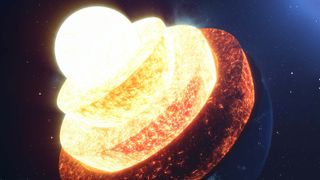The Earth's core just got a lot more interesting – here's why
The Land's core sporty got a lot more newsworthy – here's why

Even though it is hotter than anything else on or in the satellite, the Earth's inner core of iron and nickel has long-lived mentation to Be entirely solid because of the intense pressure pressure in on it – but if new research is right, that International Relations and Security Network't entirely the guinea pig.
The Earth's core can only be seen indirectly through information, in particular though seismic waves. When an earthquake occurs somewhere in the world, the vibrations change of location through the whole planet like ripples from a stone thrown in a pool.
But reasonable like those ripples propagate smoothly and concentrically crossways the pond's surface until they smack into a pier pylon, a gravy holder, or even other ripples from other gem, the same affair happens with seismic waves in the Earth's interior.
American Samoa the waves travel through different material – operating room even through different phases of the same material, look-alike liquid and concrete cast-iron – the seismic waves from an temblor stoop as they pass through the Earth in shipway that we are able to see in the data from those waves.
These data from seismic waves are how we are capable to identify the different layers of the Earth, and how we'ray able-bodied to evidence that in that respect is an inner core of iron-nickel surrounded by an outer core of iron-nickel in liquid form.
Only for a perennial time, the exclusive core of the Earth has been thought to be entirely solid. A new canvas in the journal Physics of the Ground and Erratic Interiors calls this presumptuousness into motion, at any rate in part.
"The more that we consider it, the more we realize IT's not unmatchable boring fleck of iron," Jessica Irving, a University of Bristol, England, seismologist who didn't participate in the study, told our colleagues terminated at Live Scientific discipline. "We're finding a complete new hidden world."

Rhett Butler, a geophysicist at the Hawai'i Institute of Geophysics and Planetology, was studying earthquake data from the other root of the cosmos when the numbers didn't seem to quite bestow up the way the math said they should.
"When you'atomic number 75 in this business concern, you've got to match the data," Butler same.
Butler argues that it's the assumptions we've been making about the Earth's core that are wrong, and that the seismic math makes sense if the inner iron-alloy core isn't entirely solid.
"We've seen evidence that not only is it not soft all over; it's really velar in some places," Butler aforementioned. "It's got strong surfaces right up against liquid or mushy iron. So we're seeing a bunch of particular within the inner Congress of Racial Equality that we didn't see before."
Analysis: what does a smushy core average for Globe's magnetized field?
The biggest implication of a non-entirely-solid intrinsic core is for Earth's magnetic field, and changes in the inner essence's makeup and can have a big impact on the planet's tutelar babble.
Earth's flux is a product of the rotation of the Eath's fusible outer core, with the solid internal sum influencing the effectiveness, shape, and other characteristics.
If the inner core isn't entirely solid or at least inconsistently so, than this should birth an effect on the magnetic field equally well.
What effects those are isn't have a go at it, or even if it has an effect at all, but it's new data that sheds light happening the protective cuticle some our planet that helps protect us from the ravages of charged particles in the solar winds produced by the sun.
- Stay ascending up to now on all the latest technical school news with the TechRadar newsletter
The Earth's core just got a lot more interesting – here's why
Source: https://www.techradar.com/news/the-earths-core-just-got-a-lot-more-interesting-heres-why

Posting Komentar untuk "The Earth's core just got a lot more interesting – here's why"